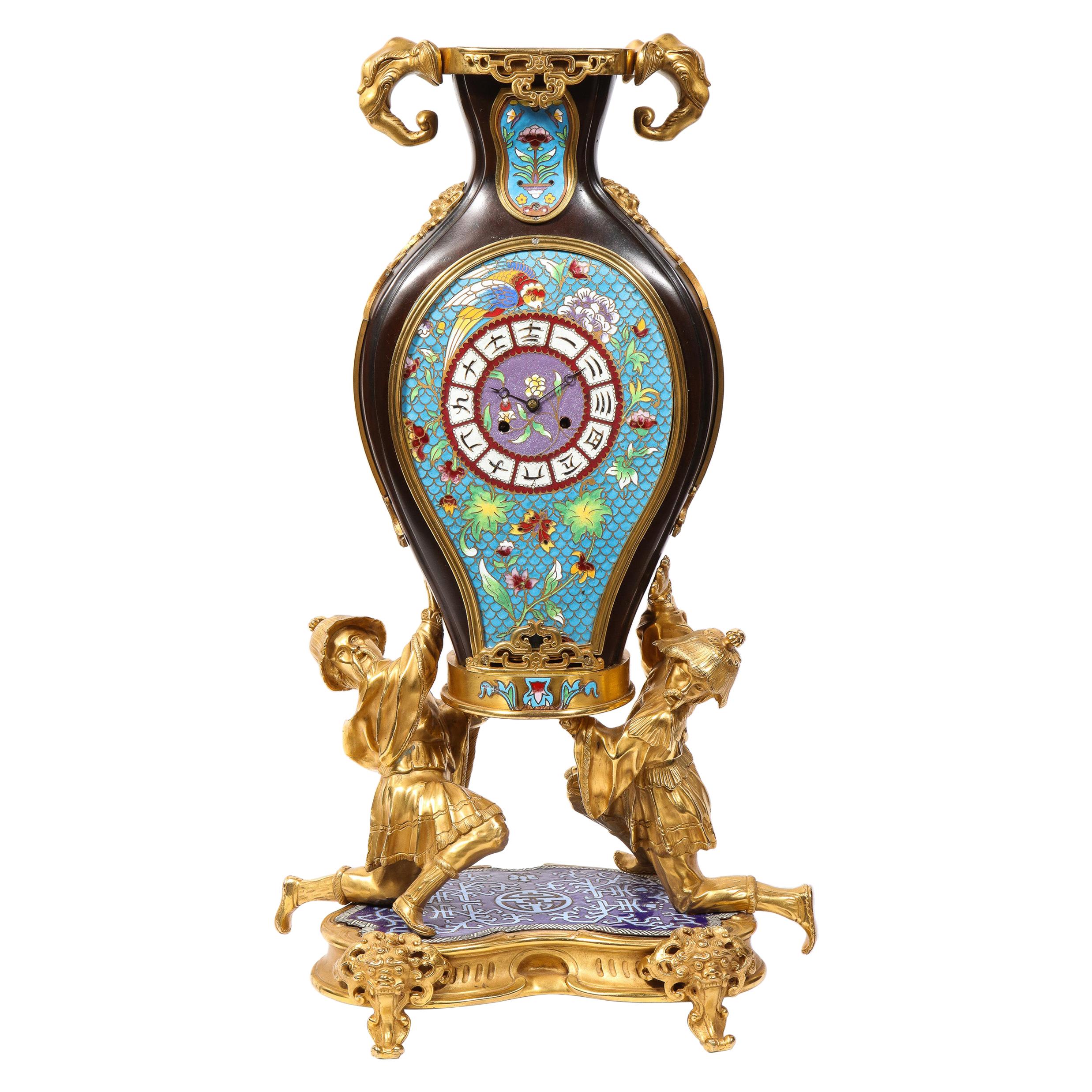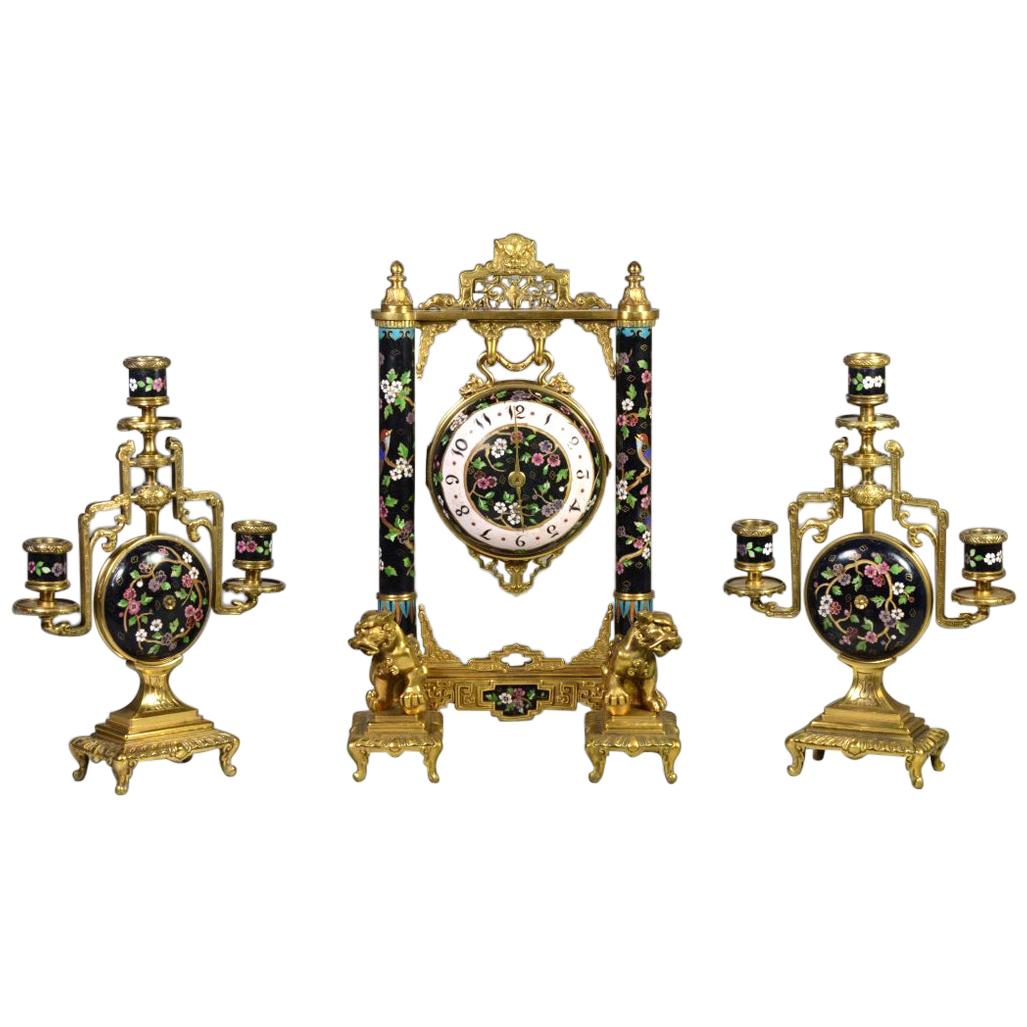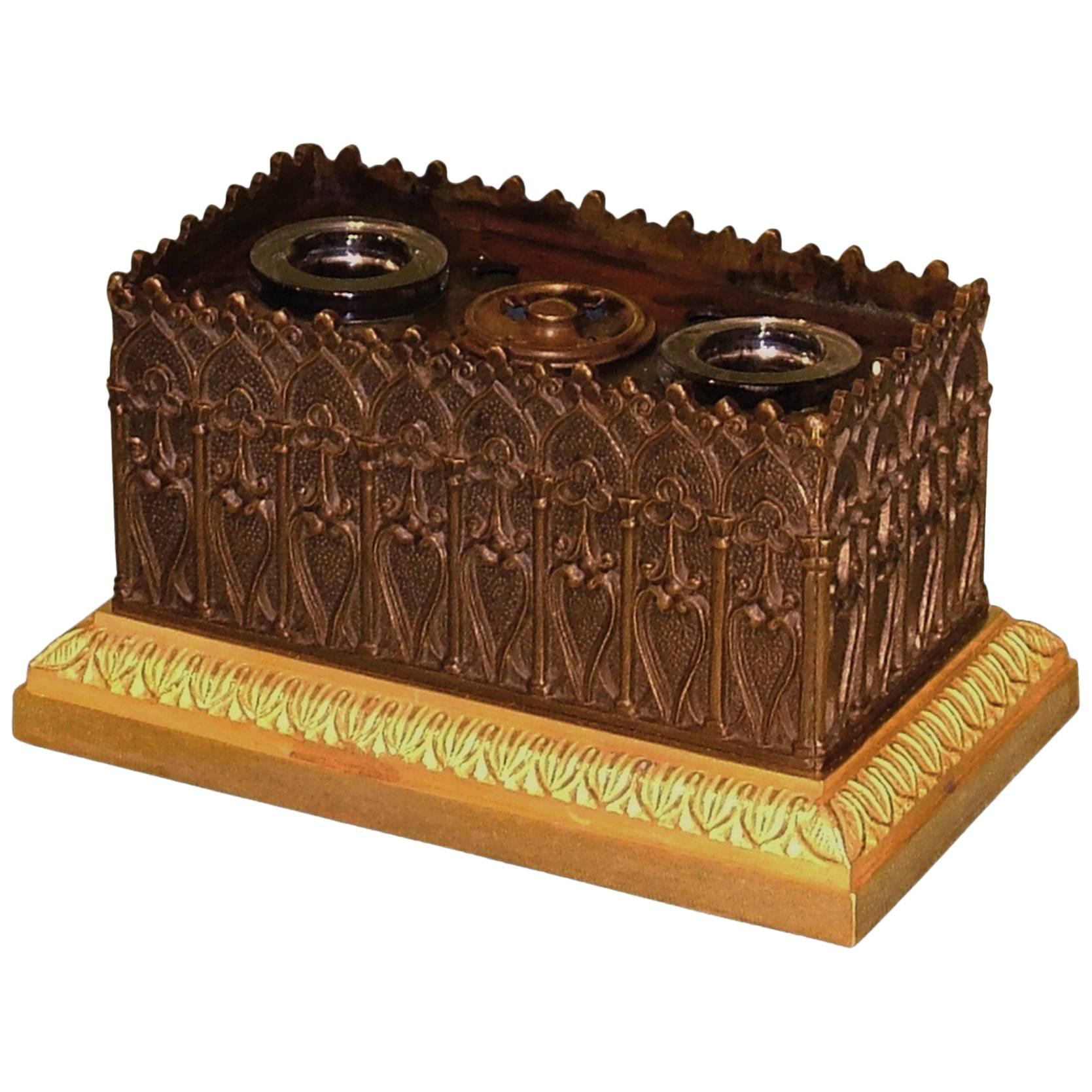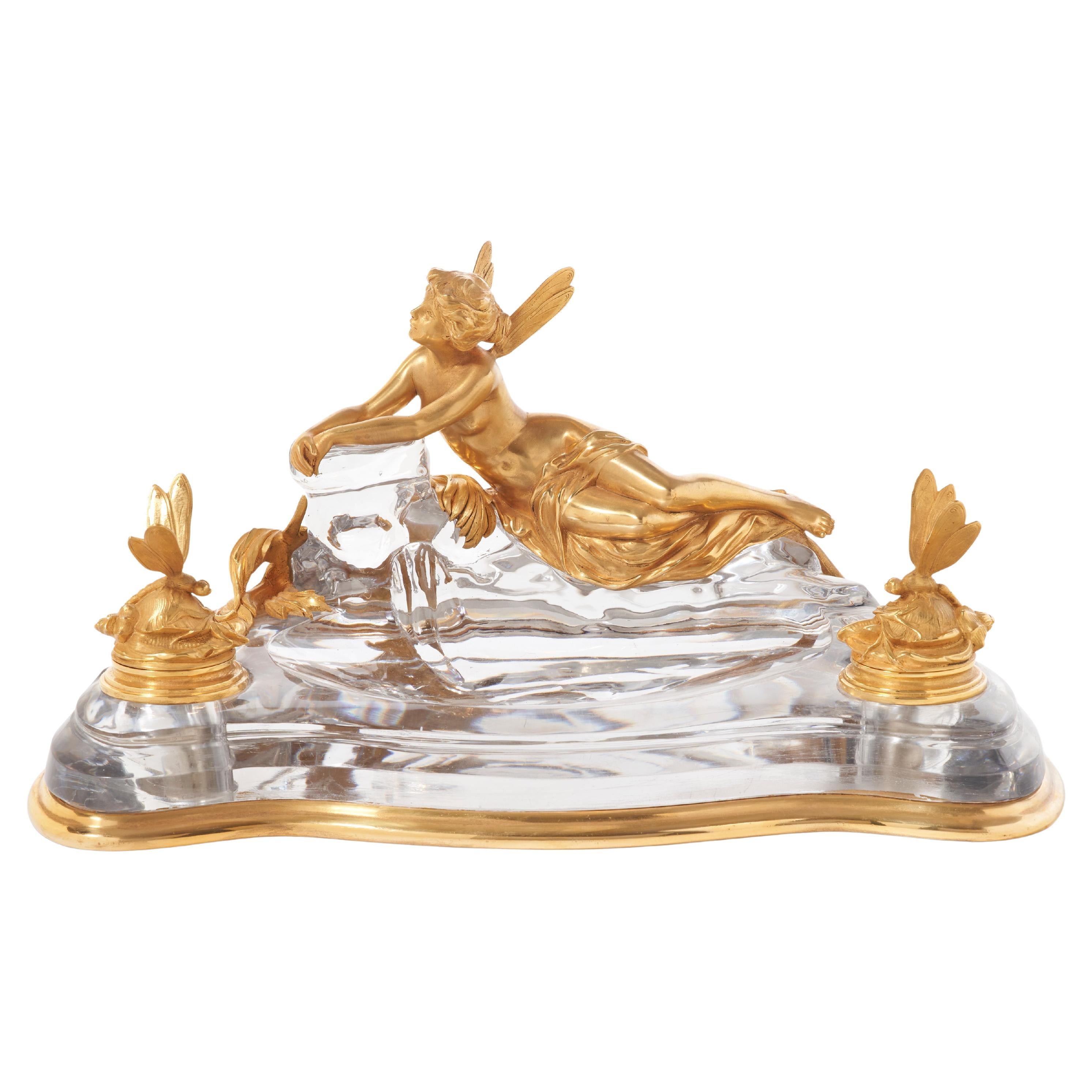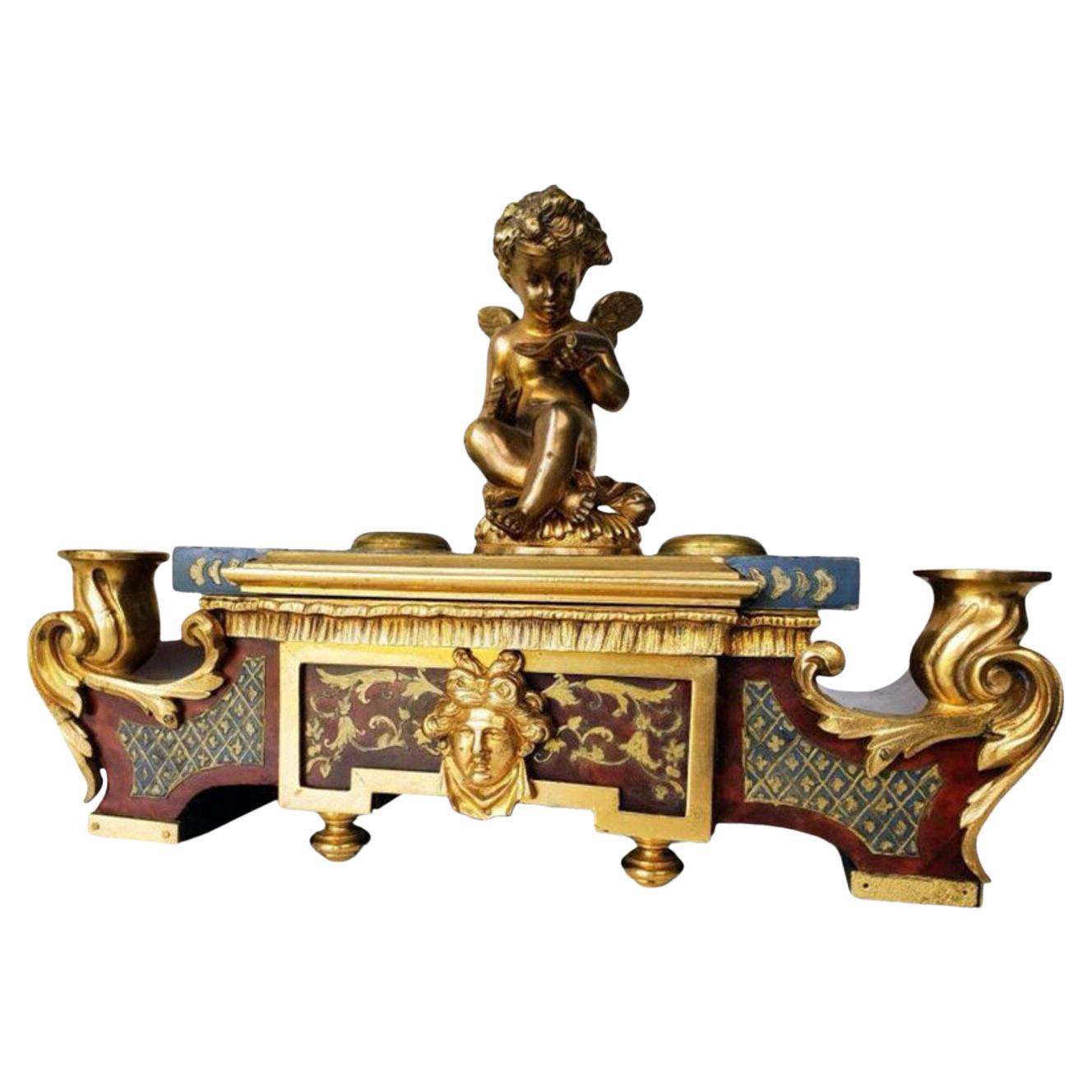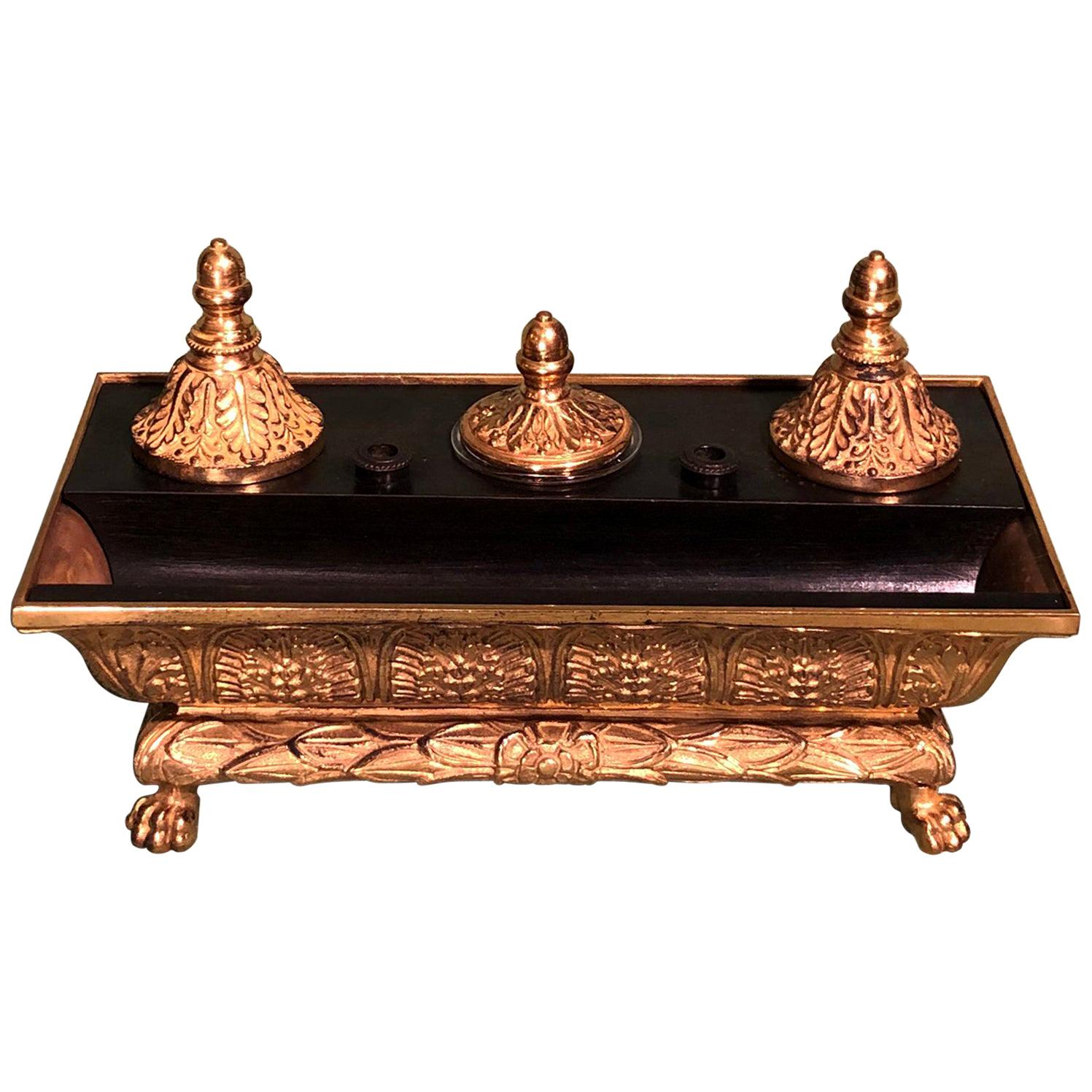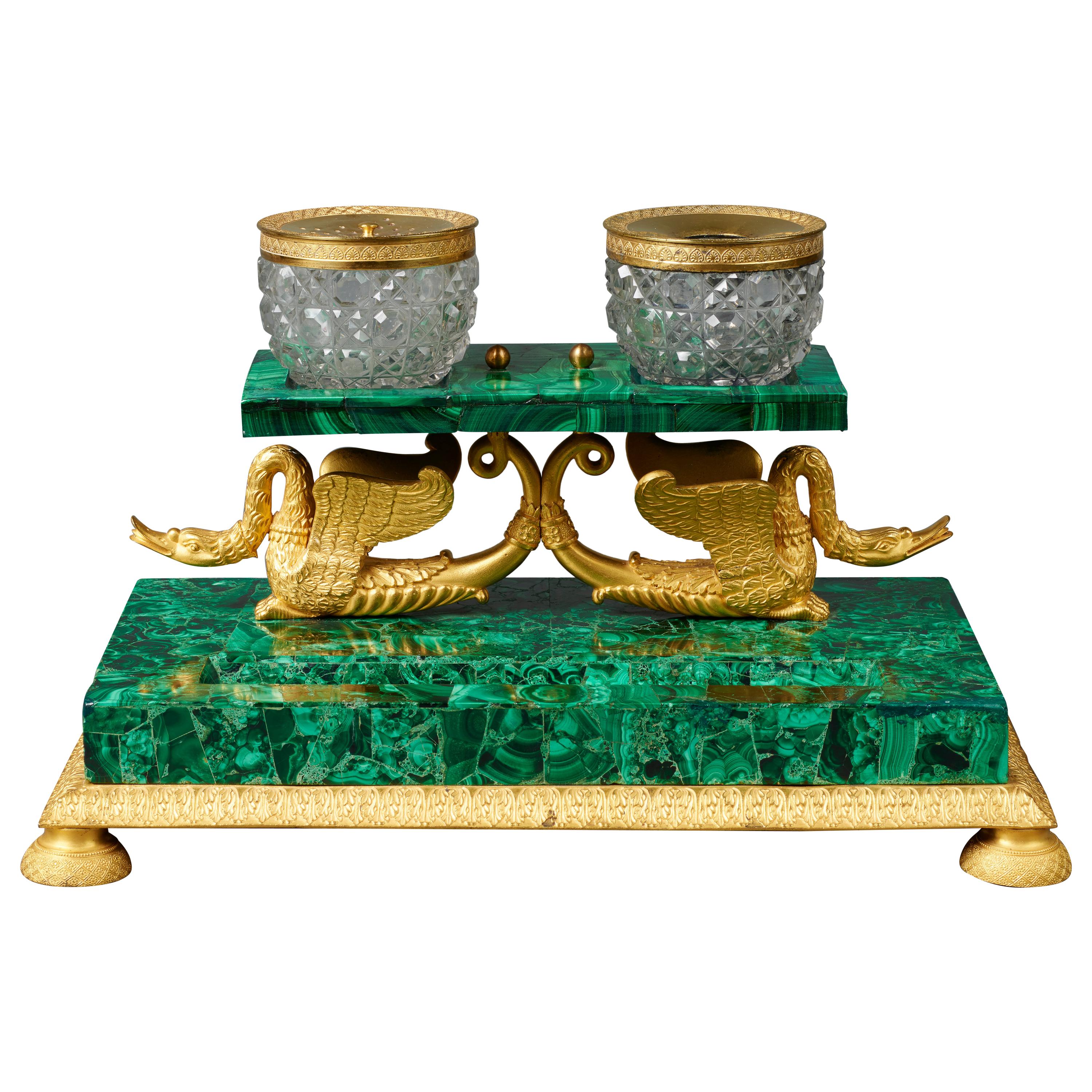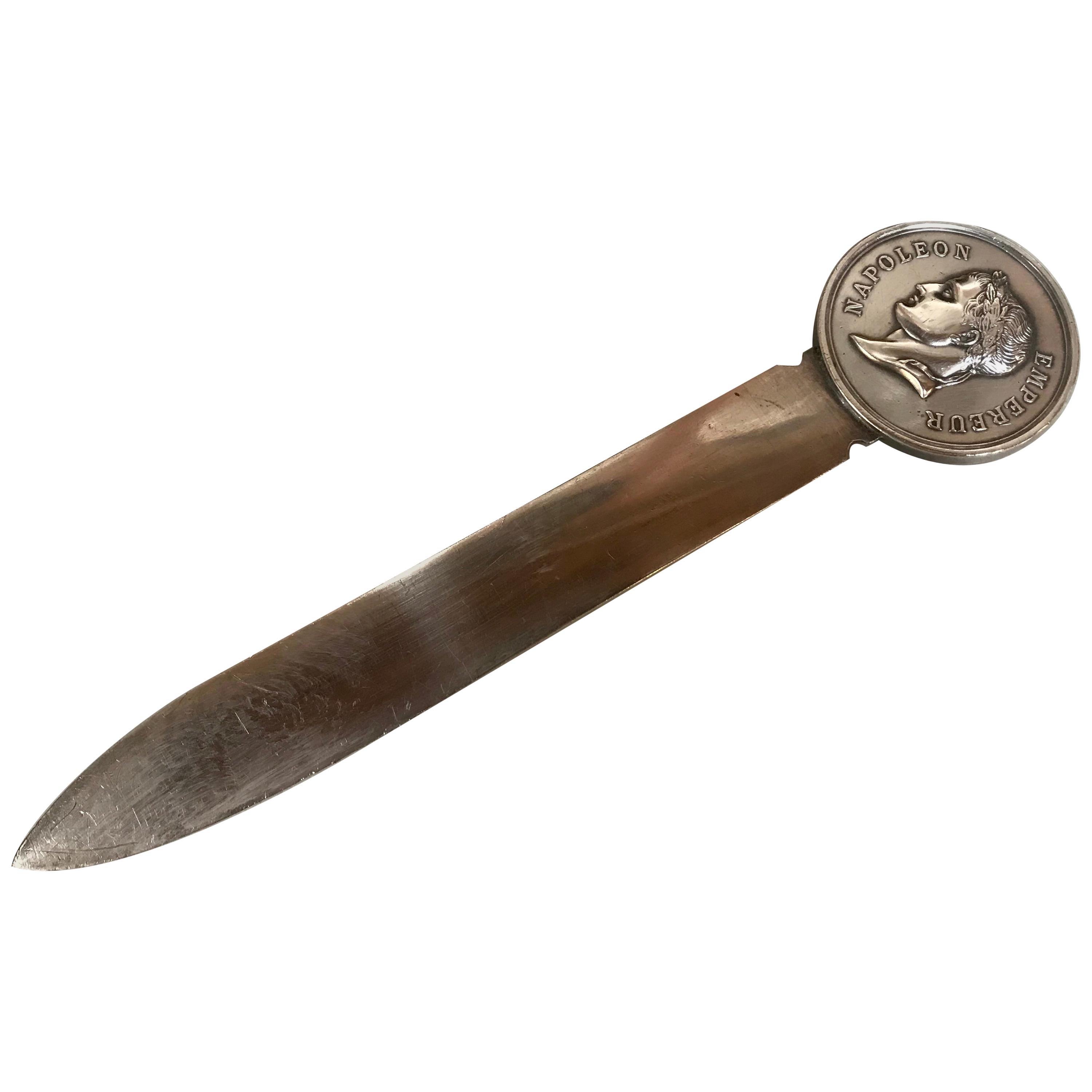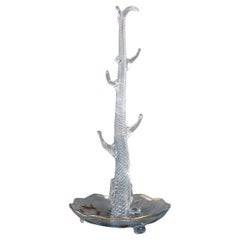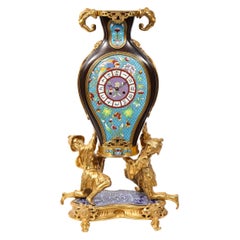
French Japonisme Ormolu and Cloisonné Enamel Encrier Emile Reiber for Christofle
View Similar Items
Want more images or videos?
Request additional images or videos from the seller
1 of 10
French Japonisme Ormolu and Cloisonné Enamel Encrier Emile Reiber for Christofle
About the Item
- Attributed to:Christofle (Maker)Emile Reiber (Maker)
- Dimensions:Height: 3.94 in (10 cm)Width: 8.86 in (22.5 cm)Depth: 5.91 in (15 cm)
- Style:Japonisme (Of the Period)
- Materials and Techniques:
- Place of Origin:
- Period:
- Date of Manufacture:circa 1880
- Condition:Wear consistent with age and use.
- Seller Location:Saint-Ouen, FR
- Reference Number:Seller: T 51391stDibs: LU261236996193
About the Seller
4.9
Vetted Seller
These experienced sellers undergo a comprehensive evaluation by our team of in-house experts.
1stDibs seller since 2017
57 sales on 1stDibs
Typical response time: 1 hour
More From This SellerView All
- French Japonisme Lacquered Metal Jardinière on Ormolu Stand Signed MarnyhacBy Maison Marnyhac 1, Edouard LievreLocated in Saint-Ouen, FRJardinière Médicis vase shape in copper with gold lacquered decoration on a burgundy background of a Japanese landscape with a volcano and an eagle ...Category
Antique 1870s French Japonisme Planters, Cachepots and Jardinières
MaterialsMetal, Bronze
$18,400 Sale Price20% Off - Famille Rose Qianlong Period Enamel Inkwell by L'Escalier de Cristal C.1880By L'Escalier de CristalLocated in Saint-Ouen, FRA Famille Rose Painted Enamel inkwell set Qianlong Period (1736-1795) by l’Escalier de Cristal It consists of a fretworked tray with raised edges in blackened wood surrounded by a fine gilded bronze ring, on which rests two Famille Rose Qianlong Period (1736-1795) hexagonal inkwells with pierced tops, one with original glass container, decorated with polychrome stylised flower heads and foliate scrollwork. This inkwell is characteristic of the productions of the Maison de l'Escalier de Cristal, it shows a hybrid realization, using ancient Asian elements, used as a container for feathers and ink. Stamped «Escalier de Cristal Paris» Circa 1880 L’Escalier de Cristal, Parisian firm created about 1800 by Mme veuve Desarnaud, famous under the French « Restoration » for its decorative objects combining crystal and bronze. She was awarded a gold medal at the 1819 Paris Exposition des Produits de l’Industrie for an outstanding gilt-bronze mounted crystal dressing table. Located in Paris, at the Palais-Royal, Galerie de Valois, L’Escalier de Cristal was bought out around 1830 by Boin, and then by Lahoche in 1840. The company owed its rise to a position amongst the most im-portant Paris decorative wares shops to Lahoche, who expanded considerably the business and entered later in partnership with his son-in-law to set up in 1852 Lahoche et Pannier...Category
Antique 1870s French Japonisme Inkwells
MaterialsOrmolu, Enamel
- Émile Gallé (1846-1904) French Enameled Ring Tree Cristallerie circa 1885By Emile GalléLocated in Saint-Ouen, FRÉmile Gallé (1846-1904) Extremely Rare Baguier shaped tree trunk blue “light blue moon” (Clair de Lune) glass enameled designed with two grasshoppers, an ant and a fly. Signed E.Gall...Category
Antique 1880s French Japonisme Glass
MaterialsArt Glass
$9,822 Sale Price25% Off - Luc Lanel & Christofle for Compagnie Générale Transatlantique a Set of Six CupsBy ChristofleLocated in Saint-Ouen, FROrfèvrerie Christofle for "Ile de France" 1949 Compagnie Générale Transatlantique Paquebot A set of six silvered metal cups Monogr...Category
Vintage 1940s French Art Deco Tableware
MaterialsMetal
$2,720 Sale Price / set20% Off - French 19th Century Pair of Lacquered Bamboos Japonisme VasesBy Ferdinand Barbedienne, Edouard LievreLocated in Saint-Ouen, FRA 19th French century pair of Lacquered Bamboos Japonisme vases. An amazing pair of tall cylindrical bamboo vases decorated in Japanese Gold and Sil-ver Hiramaki-E Lacquer with Pavilions in The Mist and Weaving Figures, Flown Over by a Pair of Cranes. Enclosed in a Sino-Japanese Inspiration Golden and Brown Patina Bronze Mount Featuring Elephant Heads, Partially Openwork Branches and Salamanders Forming Side Handles. Circa 1870 Attributed to Édouard Lièvre (1828-1886) and Ferdinand Barbedienne (1810-1892) Édouard Lièvre (1828-1886) is one of the most talented and prolific designer and industrialist of the 19th Century, his repertoire is sometimes Sino-Japanese or Neo-Renaissance, whether in furniture or works of art, we can note in particular the parade bed of Valtesse de La Bigne, furniture commissioned by the painter Édouard Detaille or even Sarah Bernhardt, and the famous works in collaboration with Maison Christofle or those in gilded bronze and cloisonné enamel edited by Ferdinand Barbedienne, presented at the Universal Exhibitions in 1878, 1889 and 1900. He was both a draftsman, painter, illustrator, engraver, ornamentalist and cabinetmaker, first trained in the studio of the painter Thomas Couture, Lièvre was then fully immersed in the world of decoration, creation and ornamentation and provides designs for manufacturers and merchant-publishers. Often assisted by his brother Justin, he first produced works of art for his own apartment, seeking out the finest craftsmen to execute his designs for bronzes, ceramics, fabrics and luxury furniture from great virtuosity and great taste. He then collaborated with the cabinet-maker Paul Sormani, as well as haberdasher merchants such as the Escalier de Cristal, bronziers such as Maison Marnyhac and especially Ferdinand Barbedienne as on our vases with bronze mounts characteristics of Edouard Lièvre's work. Born in 1810, died in Paris in 1892, Ferdinand Barbedienne, the most important caster of bronze pieces of art during the second half of the 19th Century, created and directed in Par-is one of the major artistic foundries of his time. Barbedienne specialized in classical reproductions, whose models were exposed in famous European museums. Their illustrated catalogues included many diverse objects such as busts, ornemental sculpture (clocks, candelabras, cups) sometimes even life-sized and bronzes for furniture. Apart from his own produc-tion, Barbedienne worked for the most renowned sculptors such as Barrias, Clésinger and Carrier-Belleuse. All his works were highly esteemed and he, himself honored by contemporary critics. At the London exhibition in 1851 Barbedienne’s firm won two « Council medals ». At the 1855 Universal Exhibition, he won a medal of honor. The success of Barbedienne’s firm brought him many official commissions, such in about 1860, as Barbedienne supplied bronzes for furniture for the Pompeian Villa of Prince Napoléon-Joseph, located avenue Montaigne in Paris. At the London Universal Exhibition of 1862 Barbedienne won medals in three different categories: Furniture, Silversmith work and Artistic bronzes. Barbedienne was made an officer of the Légion d’Honneur in 1867 and Commander in 1878 when he was compared with « a prince of industry and the king of bronze casting ». His glory did not decline with the passage of the time for at the Universal Exhibition of 1889 the critics thanked Barbedienne for the example he set for other bronze-casters by the perfection of his bronzes. “Japonisme” in the second half of the 19th century, was a craze for everything that came from Japan or imitated its style. The word was first coined in a series of articles published by Philippe Burty, from May 1872 to February 1873, in the French magazine “la Renaissance Littéraire et Artistique”. Far from the Academic sphere, artists seeking for new ways of expression, appropriated this discovery. Manet and the impressionists led the way to half a century of enthusiasm for Japanese art, and largely contributed to the esthetical revolution Europe experienced between 1860 and the beginning of the twentieth century. From 1862, The World’s Fairs provoked massive arrivals of fans, kimonos, lacquers, bronzes, silks, prints and books that launched the real era of Japonisme. With those exhibitions, the demand was boosted, the number of merchants and collectors was multiplied, and artists became passionate about this new esthetic. For them, its “primitivism” was probably its most important quality: artists were fond of the Japanese art’s capacity to be close to nature and to reconcile art and society by representing, with a lot of care, the most trivial objects. In painting, Edouard Manet, Mary Cassatt, Degas, Van Gogh, Gauguin were among those who were deeply inspired by Japanese art, affected by the lack of perspective and shadow, the flat areas of strong color, the compositional freedom in placing the subject off-center, with mostly low diagonal axes to the background. The Japanese iris, peonies, bamboos, kimonos, calligraphy, fish, butterflies and other insects, the blackbirds, cranes and wading birds, the cats, tigers, and dragons were endless sources of inspiration, appropriation, and reinterpretation for European artists. The occidental productions were combining styles and artistic conceptions instead of copying Japanese art slavishly. That is what brings to light the comparison between the artworks of Kitagawa Utamaro and Degas, of Katsushika Hokusai and Van Gogh The World’s Fairs of 1851 and 1862 in London, those of 1867, 1878, 1889 and 1900 in Paris, of 1873 in Vienna and of 1904 in Saint Louis presented a number of “Japanese-Chinese” installations with earthenware, bronzes, screens and paintings and attracted the largest amounts of visitors In Vienna, the “Japanese village...Category
Antique 1870s French Japonisme Vases
MaterialsBronze
- Theodore Deck '1823-1891', a Japonisme Polychromed Faience Quadrangular VaseBy Theodore DeckLocated in Saint-Ouen, FRTheodore Deck (1823-1891) A Polychromed Faience quadrangular vase, decorated in a cartouche with butterfly and birds on branches of prunus and peonies in the Japanese Taste on a pu...Category
Antique Late 19th Century French Japonisme Vases
MaterialsFaience
You May Also Like
- Small Bronze Vase French Art Nouveau, Christofle et Cie by Emilé ReiberBy Christofle, Emile ReiberLocated in Stockholm, SEA Bronze Vase, chiseled and partially gilt bronze en relief decorated with grasshoppers and wheat axes. The best of French Art Nouveau, Christofle et Cie...Category
Antique 1870s French Art Nouveau Vases
MaterialsBronze, Brass
- French Japonisme Ormolu, Patinated Bronze, and Cloisonne Enamel Mantel ClockBy Edouard Lievre, L'Escalier de CristalLocated in New York, NYA French Japonisme Chinoiserie Ormolu, patinated bronze, and cloisonne enamel mantel clock, Attributed to Escalier De Cristal and Edouard...Category
Antique Late 19th Century French Japonisme Mantel Clocks
MaterialsBronze, Enamel
- 19th Century French Ormolu and Cloisonné Enamel Japonisme Clock SetBy Japy FrèresLocated in New York, NYA fine chinoiserie gilt bronze and cloisonne three-piece clock set by Japy Freres. The ball encased movement hanging as a gong from a frame with bronze Chinese elements and cloisonn...Category
Antique 19th Century French Japonisme Mantel Clocks
MaterialsOrmolu, Bronze, Enamel
- Regency period bronze and ormolu gothic encrierLocated in London, GBAn early 19th century Regency period bronze and ormolu encrier, having inkwells and star pierced sander, contained in Gothic fret body, supported on leaf decorated plinth base.Category
Antique Early 19th Century English Regency Inkwells
MaterialsOrmolu, Bronze
$1,210 / set - Arman Violins Accumulations Paperweight for Christofle, France, 1980sBy Christofle, ArmanLocated in Milan, ITArman violins accumulations metal paperweight for Christofle, France, 1983.Category
Vintage 1980s French Modern Paperweights
MaterialsMetal
- Rare Art Nouveau French Ormolu and Crystal Inkwell Encrier by BaccaratBy Cristalleries De BaccaratLocated in New York, NYA Rare Art Nouveau French Ormolu and crystal inkwell Encrier by Baccarat, circa 1900, the ormolu possibly by Francois Linke. Depicting a reclined winged maiden...Category
Early 20th Century French Art Nouveau Inkwells
MaterialsCrystal, Bronze, Ormolu
Recently Viewed
View AllMore Ways To Browse
Christofle Tray
Cloisonne Tree
Encrier Antique
Japanese Cloisonne Box
Antique Pencil Holder
French Encrier
Antique Japanese Cloisonne Box
French Enamel Inkwell
Inkwell Japan
Antique Japanese Inkwell
Cloisonne Inkwell
Japanese Pencil Box
Glass Ink Well
Ink Tray
Sterling Silver Pen
Sterling Silver Pens
Desk Pen Stand
Antique Glass Ink Wells

